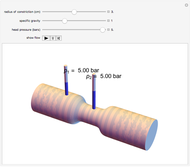Wind Tower Structure Represented by Generalized Single Degree of Freedom

Requires a Wolfram Notebook System
Interact on desktop, mobile and cloud with the free Wolfram Player or other Wolfram Language products.
This Demonstration shows how to use different shape functions to estimate the natural frequency for an actual industrial wind tower, applying the method of generalized single degree of freedom. The data for the structure of the wind tower is used to calculate the effective flexural stiffness and the effective mass to estimate the natural frequency of the tower. The shape function that produces the lowest natural frequency gives the best approximation of the motion of the tower in free vibration mode.
Contributed by: Nasser M. Abbasi (August 2013)
Open content licensed under CC BY-NC-SA
Snapshots
Details
The method of generalized single degree of freedom is applied to model a system with multiple degrees of freedom as a one degree of freedom system to estimate the (first) undamped natural frequency of the original system. A shape function is assumed for the solution that is used to obtain the effective stiffness and mass of the single undamped degree of freedom model and thus to estimate the natural frequency.
A number of shape functions are available. The shape function that produces the lowest natural frequency gives the best approximation of the actual solution. Select the shape function from the pull-down menu; the natural frequency is calculated and displayed at the top of the main display area.
The author's online report, HW 2, CEE 744, Structural dynamics, Spring 2013, contains more information about this method.
References
[1] M. Paz and W. Leigh, Structural Dynamics: Theory and Computation, 5th ed., Boston: Kluwer Academic Publishers, 2004.
[2] R. W. Clough and J. Penzien, Dynamics of Structures, New York: McGraw-Hill, 1975.

































